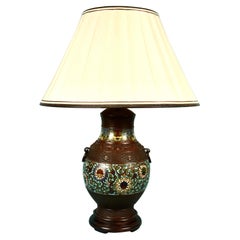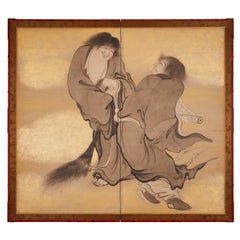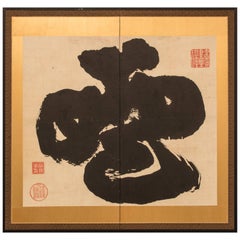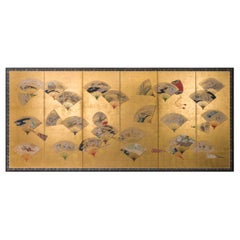Japanese Furniture
2
838
4
2
to
16
585
203
844
844
844
20
17
14
14
11
10
1
1
116
334
388
6
210
103
29
36
20
28
28
4
15
16
8
8
4
350
266
219
193
191
1,742
49,837
15,763
10,863
8,969
48
4
4
3
2
Place of Origin: Japanese
Recognized Seller Listings
Japanese Bronze Champleve Baluster Form Vase Now Electrified
Located in San Francisco, CA
A bronze Japanese champleve vase of baluster form with ring handles and foliate decoration in shades of oxblood, robin's egg blue, ochre, white and forest green.
The vase depicts st...
Category
20th Century Archaistic Japanese Furniture
Materials
Bronze, Enamel
Tōkanmuri Kabuto Samurai Helmet in the Shape of a Court CAP
Located in Milano, IT
Tokanmuri kabuto
Samurai helmet in the shape of a court cap
Momoyama to early Edo Period
17th century
The wearing of helmets that reproduced the shapes of traditional ...
Category
17th Century Antique Japanese Furniture
Materials
Iron
Japanese Two Panel Screen: Kanzan and Jittoku
Located in Hudson, NY
Prominent figures in Japanese folklore. The Chinese poet-sage Kanzan is depicted with his scroll, and the Daoist sage Jittoku with his broom. Painting bears two seals of Nakanuma Sho...
Category
Late 19th Century Antique Japanese Furniture
Materials
Gold
Japanese Two Panel Screen: Hawk Perched in Pine Tree
Located in Hudson, NY
Hawks were a popular motif in artwork because Japanese falconry, or takagari, was a sport of aristocrats such as nobles and samurai. Hawks came to symbolize nobility and strength. Su...
Category
17th Century Antique Japanese Furniture
Materials
Brocade, Silk, Paper
Japanese Two Panel Screen, Zen Calligraphy Character Cloud
Located in Hudson, NY
Meiji period (1868 - 1912) calligraphy painting. Abstract character reads: Kumo (cloud). Seal on the upper right reads Shogazen, seal on the upper left reads Hosai. Ink on mulberr...
Category
Early 20th Century Meiji Japanese Furniture
Materials
Silk, Wood, Paper
Japanese Six Panel Screen Scattered Fans
Located in Hudson, NY
Striking painting depicting scattered fans painted on gold leaf. Featuring various scenes from classic Japanese literature, flowers and birds. Mineral pigmen...
Category
Mid-18th Century Antique Japanese Furniture
Materials
Gold Leaf
Late 1940s Penny Toy Wind-Up Train, Attributed Japan
Located in Incline Village, NV
Diminutive late 1940s "penny toy like" wind-up tin toy platform train modern and sleek looking for that era; it is hand painted and lithographed in bright co...
Category
1940s Folk Art Vintage Japanese Furniture
Materials
Tin
Mid-18th Century Japanese Screen Pair, One Hundred Flowers, Chrysanthemums
Located in Kyoto, JP
Omori Soun (b. 1704)
Chrysanthemums - One Hundred Flowers
A Pair of Six-fold Japanese Screens. Ink, color, gofun and gold leaf on paper.
Dating ...
Category
Mid-18th Century Edo Antique Japanese Furniture
Materials
Gold Leaf
Japanese Bowl in Original Wooden Box
Located in Stockholm, SE
A charming Japanese graced bowl made of glazed burned clay. Beige in colour with poems written on it. it comes in its original wooden box.
Category
Late 19th Century Antique Japanese Furniture
Materials
Ceramic
Meiji Period Bell Casket by the Nogowa Foundary
Located in Lymington, Hampshire
An outstanding Meiji period mixed metal bell casket by the Nogowa foundary,
Of typical form with a shibuichi ground worked in shakudo, silver and gold with a central continuous frieze showing a three-toed dragon amongst roiling clouds and spume-flecked waves, the shoulders with fields of shakudo bosses between triple vertical lines, the knop formed by paired dragons...
Category
1880s Antique Japanese Furniture
Materials
Metal
Japanese Bronze Vase with Butterfly Design
Located in Hudson, NY
Taisho period bronze with butterfly design and handles with wheat design.
Signature on base reads: Akijo.
Category
1920s Vintage Japanese Furniture
Materials
Bronze
Japanese Spear, Edo Period, Signed
Located in Stockholm, SE
A Japanese long spear. Partly lacquered wood with a forged spearhead which is signed. High quality as most of Japanese items.
Provenance: early 20th century Swedish collection.
Category
19th Century Antique Japanese Furniture
Materials
Iron
17th Century Japanese Screen. Ink Plum Tree & Birds by Kano Naonobu.
Located in Kyoto, JP
Kano Naonobu (1607-1650)
Plum Tree and Birds
Six-fold Japanese Screen. Ink and slight color on paper.
In this evocative ink work spread over a six-panel folding screen, we see the consummation of the elegance and refinement of the Edo Kano school. This 17th century screen is a rare surviving example of a large-scale bird and flower painting by Kano Naonobu, the younger brother of Kano Tanyu...
Category
17th Century Edo Antique Japanese Furniture
Materials
Wood, Paper
Pair of 19th Century Japanese Imari Porcelain Table Lamps
Located in London, GB
A fine pair of Chinese Imari late 19th century baluster vases, decorated with floral and foliate garden scenes in the typical Imari palette of iron reds and blues with gold highlight...
Category
19th Century Antique Japanese Furniture
Materials
Porcelain
Fine Japanese Meiji Bronze Okimono Sculpture of Tiger by Mitani
Located in Shippensburg, PA
OKIMONO OF A ROARING TIGER OVER A WOODEN BASE
Japan, Meiji Period Patinated bronze signed Mitani to underside of belly
Item # 302LOC16P
This remarkable Japanese bronze okimono o...
Category
19th Century Meiji Antique Japanese Furniture
Materials
Bronze
Japanese Chawan 'Teabowl' Edo Period
Located in Stockholm, SE
A Japanese Chawan. Glazed pottery. 19th century or older. Provenance: Swedish early 20th century collection.
Category
19th Century Antique Japanese Furniture
Materials
Ceramic
Japanese Two Panel Screen, Chrysanthemums
Located in Hudson, NY
Beautiful white chrysanthemums are emphasized by heavy gold on a soft floral landscape, while gold clouds create a striking and dream-like floral scene. Gold leaf and gofun with min...
Category
Early 18th Century Antique Japanese Furniture
Materials
Gold, Gold Leaf
Vintage Chrome and Leather Folding “Ny” Tubular Steel Chair by Takeshi Nii
By Takeshi Nii
Located in Shippensburg, PA
VINTAGE CHROME AND PATINATED LEATHER "NY" CHAIR
Designed by Takeshi Nii circa 1970s
Item # 209MNW24K
A perfect example of the harmony that can be found between industrial producti...
Category
20th Century Post-Modern Japanese Furniture
Materials
Steel, Chrome
Japanese Meiji Bronze Okimono of a Wild Boar by Akasofu Gyokko
Located in Shippensburg, PA
OKIMONO OF A WILD BOAR
Japan, Meiji Period Patinated bronze over carved hardwood base Signed "Gyokko" to underside of boar
Item # 301COR20S
This remarkable sculpture was designe...
Category
19th Century Meiji Antique Japanese Furniture
Materials
Bronze
Japanese Chawan Teabowl, Edo Period
Located in Stockholm, SE
A well made Japanese Chawan. Earthenware glazed in yellow and turquoise colours. Some chips on the upper edge.
On the bottom there is an old marking, ...
Category
18th Century Antique Japanese Furniture
Materials
Ceramic
Japanese Cabinet with Drawers, So Called Tansu, Late 19th C
Located in Stockholm, SE
A high quality Japanese Tansu. The motives goes all around and is meant to be used as a free standing piece. The motives with a base of black lacquer with motives of cranes and phoen...
Category
1870s Edo Antique Japanese Furniture
Materials
Lacquer
Japanese Six Panel Screen: Egrets in Flight
Located in Hudson, NY
A siege of Egrets glide along the warm golden backdrop. Mineral pigments and gold on mulberry paper with lacquered wood trim.
Category
Early 20th Century Japanese Furniture
Materials
Gold
17th Century Japanese Screen Pair. Tiger & Dragon by Kaiho Yusetsu
Located in Kyoto, JP
Kaiho Yusetsu (1598-1677)
Tiger and Dragon
Early Edo Period, Circa 1650
A Pair of Six-fold Japanese Screens. Ink and slight color on paper.
Dimensions:
Each screen: H. 171 cm x W. 380 cm (67.5’’ x 149.5’’)
In this pair of early Edo period Japanese screens a group of tigers prowl in a bamboo grove whipped with fierce wind, while a dragon claws through clouds and mist. The dragon embodies elemental qualities - looming out of the mist, the coils of its body disappearing in the clouds. The dragon is calling for rain, symbolizing spring which is considered the fountain of life. On the other side, the tigers calls for the wind, symbolizing autumn which is considered the end of life. Tigers were familiar motifs within Japanese art from ancient times though the animals were imaginary to the people in the 17th century. While dragons and tigers are usually associated as sacred and ferocious, in this painting, both animals have rather amusing expressions. The tigers appear to glare at the dragon with cat-like eyes, and the look on the swirling dragon’s face appears almost affectionate - lending a playful flair to an otherwise magnificent theme.
The tiger and dragon are cosmological symbols of the balancing forces in the world. Screens such as this were originally meant to express the fluctuating nature of the world. For Japanese in the early Edo period, they likely suggested the powers of the cosmos. In Japan the tiger and dragon motif was originally absorbed into the circles of Zen monasteries before spreading into the secular world. The theme especially appealed to the military classes with the Kano school, the official painters to the Shogun and the samurai, being the leading contributors. The painter of this pair of screens, Kaiho Yusetsu (1598-1677), was closely patronized by the third Shogun Tokugawa Iemitsu. In his later years he worked with Kano school artists...
Category
Mid-17th Century Edo Antique Japanese Furniture
Materials
Silk, Wood, Paper
Pair of 19th Century Japanese Porcelain Lamps on French Gilded Bases
Located in London, GB
A pair of Japanese porcelain antique vase lamps of waisted form.
Dressed with French ormolu mount of unusual double gourd form, very finely painted with court officials, samurai, and gilded...
Category
19th Century Antique Japanese Furniture
Materials
Ormolu
Japanese Two Panel Screen Amorous Cranes and Turtles
Located in Hudson, NY
Japanese two panel screen: Amorous Cranes and Turtles. In Japan, cranes symbolize fidelity as they mate for life and turtles symbolize longevity. Additionally, this screen also has the Japanese motif of sho-chiku-bai, or the three friends of winter (pine, plum, and bamboo). So called the three friends of winter because all three flourish during the cold months. This screen was originally fusuma doors...
Category
1850s Edo Antique Japanese Furniture
Materials
Wood, Paper
Awaji Pottery Art Deco Japanese Vintage Vase Blue Flambe Glaze
By Awaji Pottery
Located in Wilton, CT
Awaji Pottery vase in Art Deco form with three handles curling down from the neck to join the shoulder, and striking blue flambe glaze, circa 1930. Impressed marks. 7 1/4" high, 7" d...
Category
1930s Art Deco Vintage Japanese Furniture
Materials
Pottery
Japanese Lacquered Meiji Period Cabinet
Located in Montreal, QC
Japanese lacquered Meiji Period cabinet.
Category
1880s Meiji Antique Japanese Furniture
Materials
Wood
Japanese Wooden Dagger, Late 19th C
Located in Stockholm, SE
A Japanese high quality wooden dagger. The carving is made of the highest quality as often Japanese items are. There is a signature and a poem engraved on side. Comes from an old Swedish collection...
Category
Late 19th Century Edo Antique Japanese Furniture
Materials
Boxwood
Large and Impressive Meiji Period Bronze Bison by Sano Takachika for the Kakuh
Located in Lymington, Hampshire
A large and impressive Meiji period bronze bison by Sano Takachika for the Kakuha Company, the animal powerfully modelled with his head low and turned slightly to the left and with a...
Category
Early 1900s Meiji Antique Japanese Furniture
Materials
Bronze
Japanese Teabowl, So Called Chawan, Late 19th C
Located in Stockholm, SE
A charming Japanese tea bowl glazed in beige color with a pattern of a net on top. On the rim it has a few chips that have been overpainted with gilt...
Category
Late 19th Century Edo Antique Japanese Furniture
Materials
Ceramic
Japanese Four Panel Screen: Japanese Tree Sparrows on Stacks of Bailed Rice
Located in Hudson, NY
Sparrows ravish freshly harvested rice, drying on stakes, beyond wild chrysanthemum. Mineral pigments on silk. Signed in the lower left corner, signature reads: Soetsu. With a simple...
Category
Early 20th Century Japanese Furniture
Materials
Wood, Lacquer, Silk
Japanese Mid-Century Murano Glass Blue Tile Top Brass End / Side Table
Located in New York, NY
Japanese mid-century end / side table with a Murano glass tiled top in varied shades of blue and gray, resting on a shaped brass frame with four tapered legs.
Category
20th Century Mid-Century Modern Japanese Furniture
Materials
Metal, Brass
Large Red Antique Japanese Charger Hand-Painted Children-at-Play Circa 1880
Located in Katonah, NY
This large antique charger (18 inches in diameter) is a showpiece of Japanese decorative art.
Made in the late 19th-century Meiji period, the intricat...
Category
Late 19th Century Japonisme Antique Japanese Furniture
Materials
Porcelain
Japanese Box with Cover, Edo Period, 19th Century
Located in Stockholm, SE
A small box with lid. Earthenware glazes in green and white colours. Mid-19th Century. The lid has a motive of a stylized swan.
The lid with a rest...
Category
19th Century Antique Japanese Furniture
Materials
Ceramic
Japanese Two Panel Screen, Lotus Leaves and Blossoms
Located in Hudson, NY
A lotus scene with flowers in bloom floating on the water's surface. As the lotus rise from below for an enlightening process that brings an abundance of purity and beauty. Mineral p...
Category
Early 20th Century Japanese Furniture
Materials
Wood, Lacquer, Paper
Japanese porcelain bowl glazed in white and blue, 19th C
Located in Stockholm, SE
A rectangular Japanese porcelain bowl decorated in blue and white colours. Motives of a poem and a rooster and hen.
A very attractive piece of Japanese porcelain. Both the motive an...
Category
19th Century Edo Antique Japanese Furniture
Materials
Porcelain
Japanese Two-Panel Screen: Dramatic Splash by Suzuki Goro
Located in Hudson, NY
Sumi ink on Mulberry paper, with black lacquer trim and gilded bronze hardware. Signature reads: Suzuki Goro.
Category
Mid-20th Century Japanese Furniture
Materials
Bronze
Antique Japanese Meiji-Era Silver Box with Iris Flowers
Located in New York, NY
Japanese silver box, ca 1890. Rectangular with straight sides and hinged cover. On cover top and box sides are chased and engraved iris flowers and tendril...
Category
Late 19th Century Art Nouveau Antique Japanese Furniture
Materials
Silver
Japanese Two Panel Screen: Irises on Gold
Located in Hudson, NY
Japanese Two Panel Screen: Irises on Gold
Showa period (1926 - 1989) painting, beautifully mounted with silvered hardware. Seal reads: Eishun. Mineral pigments on gold with a silk ...
Category
20th Century Showa Japanese Furniture
Materials
Brass
Large Wood Netsuke of a Shishi
Located in Milano, IT
Large wood netsuke of a shishi
Kyoto school, 18th/19th century
Height: 5.7cm
The large netsuke with a very nice patina, showing the mythical creatu...
Category
18th Century Antique Japanese Furniture
Materials
Wood
Pair of Edo Period Black and Gold Lacquer Samurai Helmet Boxes
Located in Lymington, Hampshire
A pair of Edo period black and gold lacquer Samurai helmet boxes (Hakko Bako), each of ribbed cylindrical form with a lid, a black lacquer interior,...
Category
19th Century Edo Antique Japanese Furniture
Materials
Lacquer
Japanese Two Panel Screen, Cherry Blossoms in Willow Landscape
Located in Hudson, NY
Dramatic and beautifully executed cherry blossoms trickle down the two panels with natural willows calmly coexisting with luminous gold dust fading to the ground. Mineral pigments an...
Category
Mid-19th Century Antique Japanese Furniture
Materials
Gold
Early 19th Century Japanese Screen. Cherry Blossom & Pheasants by Mori Tetsuzan
Located in Kyoto, JP
Mori Tetsuzan (1775-1841)
Pheasants and Cherry Blossoms
Two-fold Japanese screen. Ink, color, gofun, gold and silver on paper.
A two-fold Japanese bir...
Category
Early 19th Century Edo Antique Japanese Furniture
Materials
Gold Leaf
Japanese Two Panel Screen: Young Bamboo on Gold
Located in Hudson, NY
Symbolizing the Sun, gold is often used in shrines and temples in Japan. Gold has been extensively recognized to represent wealth, while bamboo is said to bring good luck due to its ability to regenerate in the forest. A beautiful composition of the two together...
Category
Late 19th Century Antique Japanese Furniture
Materials
Gold
Erotic Woodblocks Print ‘Shunga’, Kitagawa Utamaro
Located in Milano, IT
Negai no itoguchi (Unravelling the threads of desire), 1799
Oban yoko-e
Erotic prints have a primary role in the Japanese art history: sexual pleasure...
Category
18th Century Antique Japanese Furniture
Materials
Paper
Japanese Two-Panel Screen, Harbor Scene in a Modernist View
Located in Hudson, NY
Bountiful mountain overlooking a city, divided by an occupied river. The shapes and colors that make up this unique painting allow for an unconventional take on a modern harbor view....
Category
Early 20th Century Japanese Furniture
Materials
Gold, Brass
Japanese Two-Panel Screen, Pine, Cherry, and Maple
Located in Hudson, NY
Cherry blossoms and maples among ragged pines. Mineral pigments on mulberry paper with gold mist clouds. Completely remounted utilizing an antique silk brocade...
Category
Mid-19th Century Antique Japanese Furniture
Materials
Gold, Bronze
Japanese Antique Bronze Model of an Elephant and Two Tigers
Located in London, GB
Meiji period, depicting an elephant being attacked by two tigers, with Japanese mark on the base.
Rendered in impressive naturalistic detail, this charming model dates to the Japa...
Category
19th Century Meiji Antique Japanese Furniture
Materials
Bronze
Japanese Two-Panel Screen, Wading Deer
Located in Hudson, NY
In Japan, it is a Shinto belief that the deer is a treasured and sacred animal. This admirable scene captures this gentle creature in its natural habitat with beautiful detail in bot...
Category
Early 20th Century Japanese Furniture
Materials
Silk, Lacquer
Small Japanese Box with Lid in the Shape of a Rabbit
Located in Stockholm, SE
A charming small box with lid, Japanese and made in the mid 19th c in the shape of a rabbit. The box is glazed with a turquoise color.
Provenance: ...
Category
Late 19th Century Edo Antique Japanese Furniture
Materials
Ceramic
Japanese Two-Panel Screen: Cranes on Gold
Located in Hudson, NY
Early Kano School painting of pine trees overlooking two beautifully painted cranes and floral design in a natural setting by water’s edge. Mineral pig...
Category
Late 18th Century Antique Japanese Furniture
Materials
Gold, Gold Leaf
Japanese ceramic box with lid, 19th c
Located in Stockholm, SE
A Japanese ceramic box with lid. The glazing has motives of flying swans. A signature at the bottom of the box.
Category
Late 19th Century Edo Antique Japanese Furniture
Materials
Ceramic
Japanese Two Panel Screen: Mandarin Ducks Among Dry Lotus
Located in Hudson, NY
Natural scene of Mandarin ducks gliding gracefully amongst the water.
Mineral pigments on silk with silk brocade border and natural wood trim. Seal reads: Kei.
Category
Early 20th Century Japanese Furniture
Materials
Silk, Wood
A fine Meiji period bronze of a fruit picker by UDAGAWA
Located in Lymington, Hampshire
His bronze work is a collection in the Japanese Art Department of Ashmolean Museum, Oxford. This work, a farmer’s wife feeding a baby at lunch on a bench (bronze), is also reproduced in Professor HARADA Jiro’s article Studio: Japanese Art and Artists of Today V Metal work (page 102)
His original name was UDAGAWA Sutejiro 宇田川捨次郎, which he used on his work until Meiji 39. He exhibited at the Third (Meiji 23, 1890) and Fifth (Meiji 36, 1903) at the Inland Industrial Exhibition (Naikoku kangyo hakurankai) --- in both cases using his earlier name Udagawa Sutejiro. In Meiji 39 he adopted his new art name Udagawa Kazuo. He exhibited at major exhibitions abroad: P-142 (Paris Great Expo in 1900, section 1), Q-43, 88 (Paris Great Expo in 1900, section 2), R-531 (Paris Great Expo in 1900, award winning section), S-123 (St Louise...
Category
Late 19th Century Antique Japanese Furniture
Materials
Bronze
17th Century Japanese Screen Pair, Cranes
Located in Kyoto, JP
Cranes
Anonymous, Kano School.
Edo period, second half of the 17th century.
Pair of six-panel screens. Ink, pigment gofun and gold l...
Category
1670s Edo Antique Japanese Furniture
Materials
Gold Leaf
Japanese Six Panel Screen: Plain Silver Leaf on Paper
Located in Hudson, NY
(no image) With beautiful oxblood color lacquer frame with 19th century bronze mounts.
Category
Early 20th Century Japanese Furniture
Materials
Bronze, Silver Leaf
Japanese Two Panel Screen: Flowering Vines and Wisteria
Located in Hudson, NY
Wisteria represents sentiments of love and longevity as vibrant floral colors dance dramatically amongst the two panels. Mineral pigments on Mulberry paper with a natural wood trim....
Category
Early 20th Century Japanese Furniture
Materials
Wood, Paper
Japanese Two Panel Screen: Horses in Stable
Located in Hudson, NY
A pair of captivating black and white horses, believed to define hard work and power in Japanese mythology, are beautifully rendered in this painting of mineral pigments on mulberry ...
Category
Early 19th Century Antique Japanese Furniture
Materials
Bronze, Gold Leaf
Recently Viewed
View AllMore Ways To Browse
Danish Display Case
Display Case Denmark
Door Latch
Chinese Wood Carved Doors
Curved Top Display Case
Danish Display Cabinet
Display Cabinet Denmark
Back Plate Door
Chinese Small Box
Dutch Oak Cabinet
Collar Display
Dining Commode
Dutch Doors Used
Chinese Hand Carved Panel
Jewelry Box With Glass
Dining Room Table And Chairs Art Nouveau
Distressed Painted Drawers
Display Shelf With Glass Doors





